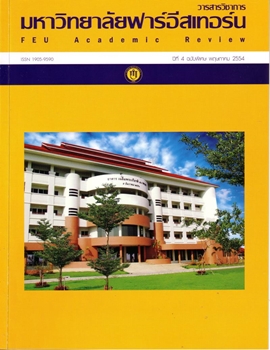การพัฒนาชุมชนแบบมีส่วนร่วมเพื่อสร้างความเข้มแข็งอย่างยั่งยืนตามแนวคิดเศรษฐกิจพอเพียงในหมู่บ้านสบเส้า ตำบลทาสบเส้า อำเภอแม่ทาง จังหวัดลำพูน ในระยะที่ 1
Main Article Content
Abstract
การวิจัยนี้มีวัตถุประสงค์ 3 ประการ ดังนี้ ศึกษาสภาพของทรัพยากรที่แท้จริงในชุมชน ศึกษาสภาพปัญหาและความต้องการของประชากรในชุมชนที่มีต่อการพัฒนาชุมชน และศึกษาแนวทางและความเป็นไปได้ในการนำทรัพยากรมาใช้ผ่านกระบวนการการมีส่วนร่วมตามแนวคิดเศรษฐกิจพอเพียง การวิจัยครั้งนี้เป็นการวิจัยเชิงปฏิบัติการแบบมีส่วนร่วมโดยมีการจัดเวทีให้ชุมชนในหมู่บ้านสบเต้า ตำบลทาสบเส้า อำเภอแม่ทา จังหวัดลำพูนเพื่อร่วมกันศึกษาและค้นหาแนวทางอันเป็นรูปธรรมในการพัฒนาชุมชนให้เป็นหมู่บ้านเศรษฐกิจแบบพอเพียง และได้มีการเก็บแบบสอบถาม สัมภาษณ์ทั้งกลุ่มตัวอย่างชาวบ้านในพื้นที่วิจัยจำนวน 322 ครัวเรือน
ผลการศึกษาพบว่าภายในชุมชนมีทรัพยากรธรรมชาติซึ่งเป็นทรัพยากรดิน และทรัพยากรน้ำที่อุดมสมบูรณ์โดยในชุมชนมีจำนวนครัวเรือนทั้งหมดจำนวน 322 ครัวเรือนและมีประชากรที่อาศัยอยู่ในชุมชนจำนวน 884 คนโดยประชากรส่วนใหญ่เป็นเพศหญิงมากกว่าเพศชาย คิดเป็นร้อยละ 50.68 ประชากรส่วนใหญ่มีอายุอยู่ในช่วง 41-60 ปี คิดเป็นร้อยละ 36.65 ซึ่งสถานภาพของประชากรส่วนใหญ่นั้นได้สมรสแล้ว คิดเป็นร้อยละ 60.86 ในส่วนของระดับการศึกษาพบว่าส่วนใหญ่มีการศึกษาอยู่ในระดับประถมศึกษา คิดเป็นร้อยละ 68.21 และมีอาชีพรับจ้างทั่วไป คิดเป็นร้อยละ 54.53 ส่วนใหญ่มีรายได้อยู่ในช่วงระหว่าง 1,000 ถึง 3,000 บาทคิดเป็นร้อยละ 34.62 ประชากรในชุมชนดังกล่าวมีความสามารถพิเศษหลายด้าน เช่น ช่างก่อสร้าง ช่างไม้ งานฝีมือ การทำอาหาร ทำขนมและการจัดสาน เป็นต้น นอกจากนี้ภายในชุมชนมีการรวมกลุ่มของเยาวชนอย่างเข็มแข็งโดยมีการจัดตั้งชมรมชื่อว่า จิตอาสารวมใจรักพัฒนาทาสบเส้าและมีการจัดทำเว็บไซต์ของชมรมคือ www.jasclub.com และมีทรัพยากรทางการท่องเที่ยวคือ อ่างเก็บน้ำแม่เส้า สถานทีปั่นจักรยานออกกำลังกาย
การออมและภาระหนี้สินของประชากรในชุมชนนั้น พบว่า ส่วนใหญ่เป็นครัวเรือนที่ไม่มีเงินออมคิดเป็นร้อยละ 64.60 และครัวเรือนส่วนใหญ่มีภาระหนี้สิน คิดเป็นร้อยละ 58.07 ในการศึกษาสภาพปัญหาของชุมชนนั้นได้มีการแบ่งปัญหาที่เกิดขึ้นออกเป็น 4 ด้าน คือ ปัญหาด้านกายภาพ ปัญหาขยะ น้ำประปาหมู่บ้านไม่ไหล ปัญหาด้านสังคม คือ เยาวชนคิดยาเสพติด การเจ็บป่วยของผู้สูงอายุ ปัญหาด้านเศรษฐกิจ คือ หนี้สิน การว่างงาน ปัญหาด้านการจัดการ คือ การจัดการระบบน้ำดื่ม สำหรับระดับความสามารถในการพึ่งพาตนเองตามหลักเศรษฐกิจแบบพอเพียงโดยรวม พบว่าอยู่ในระดับน้อย จากข้อมูลของชุมชนที่ได้ทำการศึกษาในช่วงระยะที่ 1 ทำให้เกิดโครงการพัฒนาชุมชนเพื่อส่งเสริมให้ชุมชนเป็นหมู่บ้านเศรษฐกิจพอเพียงซึ่งมีทั้งหมด 9 โครงการคือ โครงการให้ความรู้ด้านการพัฒนาบทบาทของสมาชิกในชุมชน โครงการเพิ่มผลผลิตทางการเกษตร โครงการพัฒนาผลิตภัณฑ์ชุมชนโครงการสมุนไพรชุมชน โครงการการฟื้นฟูและสืบสานศิลปวัฒนธรรมพื้นบ้าน โครงการพัฒนาสิ่งแวดล้อม โครงการการผลิตแก๊สชีวภาพเพื่อใช้ในครัวเรือน โครงการจัดตั้งศูนย์เศรษฐกิจพอเพียง และโครงการจัดทำบ้านพักโฮมสเตย์
Abstract
The purpose of this research aimed to study the condition of real resources in community, to study problems and people’s need effected to community development, to study the capability level of community by self-reliance regarding sufficiency economy philosophy, to study approach and feasibility by using resource through participating process and to study the projects under the resource that created by community according to sufficiency economy philosophy. This study applied Participatory Action Research (PAR) to arrange meeting stage for community (Focus Group Discussion) in Sobsao village, Tambon Ta-Sobsao, Maeta Cistrict, Lumphun Province to participate, study and find tangible ways in community development to sufficiency economy village which participated by brainstorming from many affiliate groups. This study employed ratified purposive, collected and interviewed data from inhabitants 322 families.
The results were found that the community had natural resources consist of rich soil and water resources. There were 322 families and 884 people, most of the population were female (50.68%). Most of them were between 41 and 60 years old (36.65%) and married (60.86%). For the highest education level was found that most of all had primary level and they have worked as employees (68.21% and 54.53% respectively). They had revenue between 1,000 and 3,000 baht (34.62%). Meanwhile, they had many talents such as building, wooden, handicraft, cooking and weave etc. In addition, they gave formed the strong youth group in the community. The set up “Jit-asa Ruam-Jairuk Pattana Ta-sobsao” club and gave been website namely “http://www.jasclub.com” that shown “Sobsao Reservoir” and bike ways for exercise etc.
The results in saving and debt were found that most of family had non-saving (64.60%) and debt (58.07%). After public hearing and Focus Group Discussion from the community, the problems were classified to 4 types; Physical problem-Garbage, Social problem-Drug addict in Youth, Economics problem-Debt and Management problem-Management drinking water system. Capability level in self-reliance as sufficiency economy philosophy in this community were low. All of these results in Phase I study caused to 9 projects to encourage the community be the sufficiency economy village; Knowledge Management in role of member project, Agricultural productivity improvement project, Community products development project, Community herb project, Restore and Inherit local art and culture project, Environmental development project, Producing biogas for use in household, Set-up sufficiency economy center project and Prepare to create home-stay project.
Article Details
1. Any views and comments in the Journal of Social Innovation and Lifelong Learning are the authors’ views. The editorial staff have not to agree with those views and it is not considered as the editorial’s responsibility.
2. The responsibility of content and draft check of each article belongs to each author. In case, there is any lawsuit about copyright infringement. It is considered as the authors’ sole responsibility.
3. The article copyright belonging to the authors and The Far Eastern University are copyrighted legally. Republication must be received direct permission from the authors and The Far Eastern University in written form.

